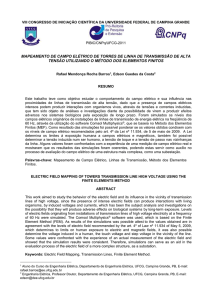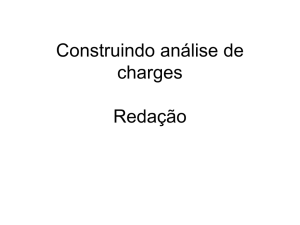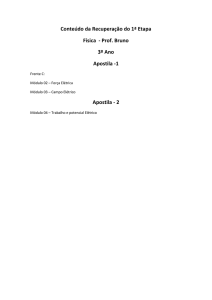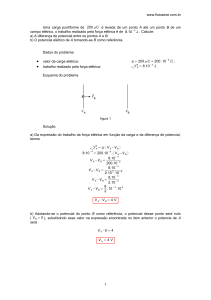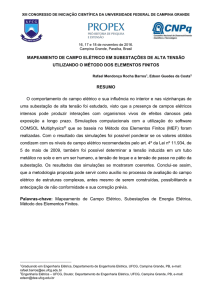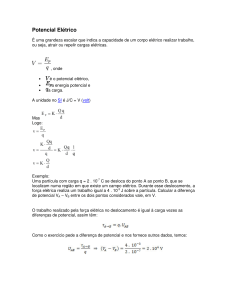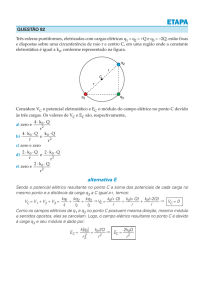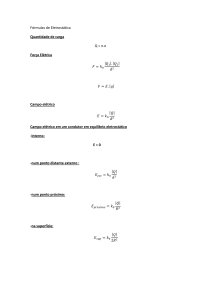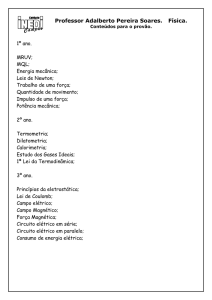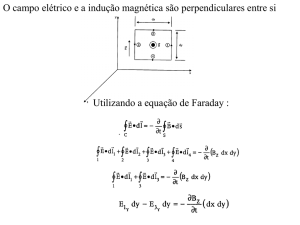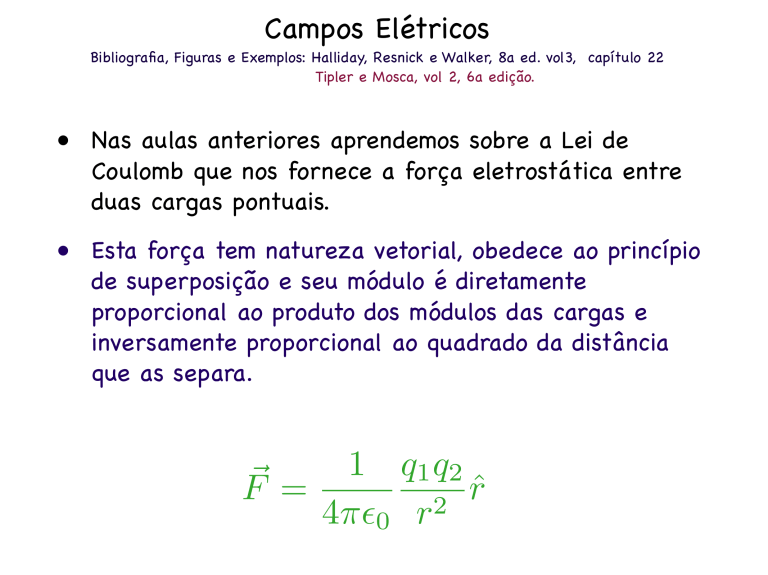
Campos Elétricos
Bibliografia, Figuras e Exemplos: Halliday, Resnick e Walker, 8a ed. vol3, capítulo 22
Tipler e Mosca, vol 2, 6a edição.
• Nas aulas anteriores aprendemos sobre a Lei de
Coulomb que nos fornece a força eletrostática entre
duas cargas pontuais. • Esta força tem natureza vetorial, obedece ao princípio
de superposição e seu módulo é diretamente
proporcional ao produto dos módulos das cargas e
inversamente proporcional ao quadrado da distância
que as separa.
1
q
q
1
2
~
r̂
F =
4⇡✏0 r2
Campo Elétrico
• Quando duas cargas estão próximas uma da outra, aprendemos que
existe uma força de atração ou repulsão elétrica entre elas. Mas como
uma carga sabe que a outra carga existe? !
• Se as partículas carregadas não se tocam, por que uma afeta a
outra já que não existe nenhuma ligação física entre elas?
!
• Uma carga elétrica gera um campo elétrico no espaço ao seu redor.
Quando uma segunda carga (carga de prova) é colocada na mesma
região do espaço, ela é afetada pelo campo elétrico gerado pela
primeira.
!
• O campo elétrico tem natureza vetorial e é constituído por uma
distribuição de vetores em cada ponto no espaço em torno do objeto
eletricamente carregado
!
• O campo elétrico “transmite a informação” para a carga de prova de
que existem mais cargas elétricas na região onde ela é colocada.
Linhas de Campo elétrico
• Abstração sugerida por Faraday para visualizar o
campo elétrico.
• As linhas de campo se afastam das cargas positivas
(onde
começam)
e
chegam
nas
cargas
negativas
Electric Field Lines S E C T I O N 2 1 - 5
711
|
(onde terminam)
dipole at a
nitude
21-10
magnitude
ent and dee, the eleccharge, the
e field falls
rved lines,
tion of the
that point.
+
(a)
charge is extremely large at points very close to the charge, and because the
second
opposite
charges on
the ends of each
bit ofto th
themselves
parallel
due to that charge alone. This is because the magnitude of the field of a single point
thread,
causing the threads to align
charge
is isrelatively
away.
Consequently,
thecharge,
field lines
near either
charge are
radial
Waage.)
charge
extremely far
large
at points
very close to the
and because
the second
Linhas de Campo Elétrico
charge is relatively far away. Consequently, the field lines near either charge are radial
++
+
themselves parallel to the field. (Harold M.
Waage.)
+
(a) Electric
field lines due to two Fpositive
IGURE
point charges. The arrows
field lines
would be reversed if both
point
cha
charges were negative.
(b) The
would
same electric field lines
shownbe
by bits of thread in oil.
(Harold w
charges
M. Waage.)
same elec
FIGURE 21-21
(a)
(b)
by bits of
M. Waage.
(a)
(b)
1) Em qualquer ponto,
a orientação de uma linha de campo
retilínea ou
a orientação tangente a uma linha de campo não retilínea é a
orientação do campo elétrico neste ponto.
!
2) As linhas de campo são desenhadas de tal forma que o número de
linhas por unidade de área, medido em um plano perpendicular às
linhas é proporcional ao módulo do vetor campo elétrico, ou seja, linhas
próximas indicam um campo elétrico é mais intenso enquanto que linhas
mais separadas indicam um campo elétrico mais fraco.
Linhas de Campo Elétrico
Como a carga está homogeneamente distribuída pela placa
todos os vetores campo elétrico tem o mesmo módulo e a
mesma orientação no espaço: Campo Elétrico Uniforme
Linhas de Campo de duas esferas
condutoras
A carga elétrica em um objeto é positiva se mais linhas de campo
saem dele do que terminam nele! A taxa entre os módulos das
cargas(b)é igual à taxa entre o número líquido de linhas saindo ou
entrando sobre cada esfera.
Conceptual
the
on
Qual o sinal das cargas em cada
esfera e qual o módulo das cargas
relativas em cada esfera?
miagmi-
e
et
e
FIGURE 21-25
Campo Elétrico de uma carga puntiforme
Vamos calcular o campo elétrico sobre uma carga de prova q0
colocada a uma distância r de uma carga q. A força eletrostática
entre as duas cargas é dada pela lei de Coulomb, ou seja:
qq
0
~
F = k 2 r̂
r
Definimos
~
F
~ =
E
q0
daí, podemos escrever
1
q
q
~
r̂
E = k 2 r̂ =
2
r
4⇡✏0 r
[N/C]
Princípio da superposição
• Como o campo elétrico é um vetor, para achar o campo
elétrico resultante de uma distribuição discreta e
estática de cargas sobre uma dada carga de prova q0,
basta somar vetorialmente os campos elétricos devido à
cada carga da distribuição sobre esta carga de prova.
F~0 = F~01 + F~02 + F~03 + ...
~0
F
1
~0 =
E
= (F~01 + F~02 + F~03 + . . . )
q0
q0
~ 01 + E
~ 02 + E
~ 03 + ...
=E
Exemplos
1) Uma carga positiva q1=+q e uma carga negativa q2=-2q estão
localizadas no eixo x em x=a e x=-a, respectivamente.
Considere as seguintes regiões no eixo x: região 1 (x < -a),
região II (-a< x <+a) e região III (x > a). Em qual ou quais
regiões existe um ponto no qual o campo elétrico resultante se
The Electric Field S E C T I O N 2 1 - 4
707
|
anula?
he x axis,
oints on the
these
21-13):
s can be
on
y
E1
E2
PI
Region I
q2 = −2q
−a
E2
E1
PII
0
Region II
q1 = +q
+a
E2
E1
PIII
Region III
FIGURE 21-13
Throughout region I, the two electric field vectors are oppositely directed.
However, each point in the region is closer to q2 (! #2q) than q1 (! "q),
so E2 is greater than E1 at each point in the region. Thus, in region I there
x
Exemplos
Line through Two Positive Point Charges
2) Uma carga positiva q1=+8nC está sobre o eixo x em
x axis at x ! x1 ! #1.0 m, and a second posenquanto
carga positiva q2=+12nC
1=-1.0m
s at xx!
Find the netuma
electricsegunda
field
x2 ! 3.0 m.
b) at point
on the
axis at x !Encontre
2.0 m.
estáB em
xx2=3.0m.
o campo elétrico resultante:
a) Em um ponto A em x=+6m
s due to q1 and q2, respectively. Because q1 is
S
b) Emq2um
pontoE 2Bpoints
em x=2.0m
, and because
is positive,
away
S
S
S
field using E ! E 1 " E 2 .
e the
riate
ctric
eat this
):
0m
q1 = +8.0 nC
q1
+
−2
q2 = +12 nC
q2
E2 E1
0
+
2
E1
4
E2
x, m
6
B
A
S
Because q1 is a positive charge, E 1 points away from q1 , at
S
both point A and point B. Because q2 is a positive charge, E 2 points away from q2 at
both point A and point B.
FIGURE 21-14
S
S
S
E ! E1 " E2 !
9
kq1
r21A
#
rn1A "
2
kq2
r22A
2
rn2A !
kq1
kq2
n"
n
i
i
(xA # x1)2
(xA # x2)2
#9
9
#
2
2
#9
RACTICE PROBLEM 21-9 Regarding Example 21-7, find
–3
e point on the x axis where the electric field is zero.
–2
–1
0
2
1
3
4
5 x, m
– 200
Exemplos
– 400
– 600
3) Uma carga pontual positiva de 8nC está na origem enquanto
outra carga também positiva de 12 nC está sobre o eixo x, em
Try It Yourself
ample 21-8 Electric Field Due to Point Charges on the x Axis
x=4m. Calcule o campo elétrico resultante no eixo y, em y=3.0m.
FIGURE 21-15
point charge q1 ! $8.0 nC is at the origin and a second point charge q2 ! $12.0 nC is on
e x axis at x ! 4.0 m. Find the electric field on the y axis at y ! 3.0 m.
S
S
S
CTURE As in Example 21-7, E ! E 1 $ E 2 .
S
Answers
points on the y axis, the electric field E 1 due
charge q1 is directed along the y axis, and the
S
ld E 2 due to charge q2 is in the second quadS
nt. To find the resultant field E , we first find
S
e x and y components of E .
y, m
E1
OLVE
over the column to the right and try these
n your own before looking at the answers.
E2
θ
P
3
eps
. Sketch the two charges and the field
point. Include the coordinate axes. Draw
the electric field due to each charge at the
field point and label distances and angles
appropriately (Figure 21-16a):
θ
2
5.0 m
1
q2 = +12 nC
+
q1 = +8.0 nC
FIGURE 21-16a
+
1
2
3
4
5
x, m
ic Field Due to Two Equal and Opposite
Charges
Exemplos
a second
chargecarga
(Figureem
21-17).
(a) Find
the elec"q is at x +q
! "aestá
4) Uma
x=a
enquanto
arbitrary point x $ a. (b) Find the limiting form of the electric
uma segunda carga -q está em
x=-a.
a) Encontre o campo elétrico sobre o eixo x em um ponto qualquer electric field at point P using the principle of superposition,
x > a.
the electric field E # due to the positive charge is in the #x did E " due
the negative charge
is in the
direction.elétrico
The disb) toEncontre
o limite
do"xcampo
para x >> a.
S
S
ive charge and x " ("a) ! x # a to the negative charge.
y
iguration on a coordinate axis
s from each charge to the field
x+a
x
a
−
−q
x−a
a
+
+q
E– E+
P
x
FIGURE 21-17


